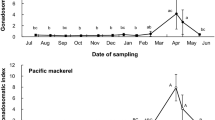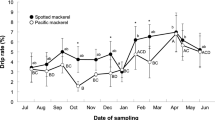Abstract
In this study, we examined differences in the proximate composition of five major muscles of the yellowtail, as well as the relation between seasonal variations in the levels of crude lipids and texture of these muscles. The differences in content among these muscles and the variations in each muscle were greater for crude lipid and moisture content than for crude protein content. The crude lipid content of Musculus latero-dorsalis correlated with that of M. carinatus dorsalis, M. latero-ventralis, M. carinatus ventralis, and red muscle. In M. latero-dorsalis, the crude lipid content started to increase in October, remained high from November to January, started to decrease in March, and was low from April to June. The firmness of M. latero-dorsalis increased from October to November and started to decrease in March. Firmness decreased concurrently with decreases in crude lipid content and increased concurrently with increases in crude lipid content. The results of this study suggest that it is possible to predict the proximate compositions of other yellowtail muscles from the proximate composition of M. latero-dorsalis. Seasonal variation in crude lipid content of the M. latero-dorsalis was found, and variations in crude lipid tended to parallel those in firmness.







Similar content being viewed by others
References
Shimizu Y, Tada M, Endo K (1973) Seasonal variations in chemical constituents of yellow-tail muscle—1. Water, lipid and crude protein (in Japanese with English abstract). Nippon Suisan Gakkaishi 39:993–999
Saeki K, Kumagai H (1979) Muscle components of wild and cultured yellowtail (in Japanese with English abstract). Shokuhin Eiseigaku Zasshi 20:101–105
Date K, Yamamoto Y (1988) Seasonal variations with growth in nutritive components in meat of cultured yellowtail Seriola quinqueradiata (in Japanese with English abstract). Nippon Suisan Gakkaishi 54:1041–1047
Ochiai A, Nabeshima H, Umeda S, Hasegawa I (1980) Gonad maturation and dynamics of crude lipid content in the body of yellowtail during the spawning season (in Japanese with English abstract). Nippon Suisan Gakkaishi 46:407–412
Gökoğlu N, Özden Ö, Erkan N, Baygar T, Metin S (1999) Seasonal variation in fat content of anchovy (Engraulis encrasicolus). Int J Food Sci Technol 34:401–402
Yildiz M, Şener E, Timur M (2008) Effects of differences in diet and seasonal changes on the fatty acid composition in fillets from farmed and wild sea bream (Sparus aurata L.) and sea bass (Dicentrarchus labrax L.). Int J Food Sci Technol 43:853–858
Celik M (2008) Seasonal changes in the proximate chemical compositions and fatty acids of chub mackerel (Scomber japonicus) and horse mackerel (Trachurus trachurus) from the north eastern Mediterranean Sea. Int J Food Sci Technol 43:933–938
Sahar A, Boubellouta T, Lepetit J, Dufour E (2009) Front-face fluorescence spectroscopy as a tool to classify seven bovine muscles according to their chemical and rheological characteristics. Meat Sci 83:672–677
Ueda Y, Watanabe A, Higuchi M, Shingu H, Kushibiki S, Shinoda M (2007) Effects of intramuscular fat deposition on the beef traits of Japanese black steers (Wagyu). Anim Sci J 78:189–194
Lebret B, Heyer A, Gondret F, Louveau I (2007) The response of various muscle types to a restriction-re-alimentation feeding strategy in growing pigs. Animal 1:849–857
Gil M, Delday MI, Gispert M, Furnols MF, Maltin CM, Plastow GS, Klont R, Sosnicki AA, Carrion D (2008) Relationships between biochemical characteristics and meat quality of Longissimus thoracis and Semimembranosus muscles in five porcine lines. Meat Sci 80:927–933
Gotoh T, Albrecht E, Teuscher F, Kawabata K, Sakashita K, Iwamoto H, Wegner J (2009) Differences in muscle and fat accretion in Japanese black and European cattle. Meat Sci 82:300–308
Brackebusch SA, McKeith FK, Carr TR, McLaren DG (1991) Relationship between longissimus composition and the composition of other major muscles of the beef carcass. J Anim Sci 69:631–640
Dinh TTN, Blanton JR, Rily DG, Chase CC Jr, Coleman SW, Phillips WA, Brooks JC, Miller MF, Thompson LD (2010) Intramuscular fat and fatty acid composition of longissimus muscle from divergent pure breeds of cattle. J Anim Sci 88:756–766
Reardon W, Mullen AM, Sweeney T, Hamill RM (2010) Association of polymorphisms in candidate genes with colour, water-holding capacity, and composition traits in bovine M. longissimus and M. semimembranosus. Meat Sci 86:270–275
Christensen M, Ertbjerg P, Failla S, Sanudo C, Richardson RI, Nute GR, Olleta JL, Panea B, Alberti P, Juarez M, Hocquette JF, Williams JL (2011) Relationship between collagen characteristics, lipid content and raw and cooked texture of meat from young bulls of fifteen European breeds. Meat Sci 87:61–65
Hagen Ø, Solberg C, Sirnes E, Johnston IA (2007) Biochemical and structural contributing to seasonal variation in the texture of farmed Atlantic halibut (Hippoglossus hippoglossus L.) flesh. J Agric Food Chem 55:5803–5808
Mørkøre T, Ruohonen K, Kiessling A (2009) Variation in texture of farmed atlantic salmon (Salmo salar L). Relevance of muscle fiber cross-sectional area. J Texture Stud 40:1–15
Andersen UB, Thomassen MS, Rora AMB (1997) Texture properties of farmed rainbow trout (Oncorhynchus mykiss): Effects of diet, muscle fat content and time of storage on ice. J Sci Food Agric 74:347–353
Kunisaki N, Takada K, Matsuura H (1986) On the study of lipid contents, muscle hardness and fatty acid compositions of wild and cultured horse mackerel (in Japanese with English abstract). Nippon Suisan Gakkaishi 52:333–336
Thakur DP, Morioka K, Itoh N, Wada M, Itoh Y (2009) Muscle biochemical constituents of cultured amberjack Seriola dumerili and their influence on raw meat texture. Fish Sci 75:1489–1498
Touhata K, Toyohara H, Tanaka M, Tokuda Y, Sakaguchi M, Tanaka H (1998) Seasonal change in muscle firmness and proximate composition of red seabream. Fish Sci 64:513–516
Touhata K, Tanaka M, Toyohara H, Tanaka H, Sakaguchi M (2000) Seasonal change in collagen content of red seabream muscle. Fish Sci 66:553–557
Ito K, Toyohara H, Ando M, Sakaguchi M (1992) Disintegration of the pericellular connective tissue of ayu muscle in the spawning season relevant to softening. Nippon Suisan Gakkaishi 58:1553
Yamashita M, Konagaya S (1990) Participation of cathepsin L into extensive softening of the muscle of chum salmon caught during spawning migration. Nippon Suisan Gakkaishi 56:1271–1277
Yamashita M, Konagaya S (1991) Hydrolytic action of salmon cathepsins B and L to muscle structural proteins in respect of muscle softening. Nippon Suisan Gakkaishi 57:1917–1922
Yamashita M, Konagaya S (1991) Proteolysis of muscle proteins in the extensively softened muscle of chum salmon caught during spawning migration. Nippon Suisan Gakkaishi 57:2163
Thakur DP, Morioka K, Itoh Y, Obatake A (2002) Influence of muscle biochemical constituents on the meat texture of cultured yellowtail (Seriola quinqueradiata) at different anatomical locations. J Sci Food Agric 82:1541–1550
Thakur DP, Morioka K, Itoh Y, Obatake A (2003) Lipid composition and deposition of cultured yellowtail Seriola quinqueradiata muscle at different anatomical locations in relation to meat texture. Fish Sci 69:487–494
Umeda S, Ochiai A (1971) On the maturation of the yellowtail cultured in the floating net from the spawning season to post-spawning period (in Japanese with English abstract). Jpn J Ichthyol 18:175–181
Shioya I, Inoue K, Abe A, Takeshita A, Yamaguchi T (2011) Beneficial effects on meat quality of yellowtail Seriola quinqueradiata induced by diets containing red pepper. Fish Sci 77:883–889
Shioya I, Takemura S, Yamaguchi T (2011) Ventilation of seawater during bleeding suppresses the occurrence of burnt meat in yellowtail Seriola quinqueradiata. Fish Sci 77:817–822
Kaseda Y, Nomura S (1973) Electromyographical studies on the swimming movement of carp I. Body movement (in Japanese with English abstract). Jpn J Vet Sci 35:335–342
Bligh EG, Dyer WJ (1959) A rapid method of total lipid extraction and purification. Can J Biochem Physiol 37:911–917
Inoue K, Morioka K, Shioya I, Mitsuboshi T, Itoh Y, Obatake A, Satake M (1998) Effects of deep seawater acclimation on components and texture of the muscle of red sea bream. Fish Sci 64:804–807
Oka H, Ohno K, Ninomiya J (1990) Changes in texture during cold storage of cultured yellowtail meat prepared by different killing methods (in Japanese with English abstract). Nippon Suisan Gakkaishi 56:1673–1678
Ando M, Toyohara H, Shimizu Y, Sakaguchi M (1991) Post-mortem tenderization of fish muscle proceeds independently of resolution of rigor mortis. Nippon Suisan Gakkaishi 57:1165–1169
Ando M, Toyohara H, Shimizu Y, Sakaguchi M (1993) Post-mortem tenderization of fish muscle due to weakening of pericellular connective tissue. Nippon Suisan Gakkaishi 59:1073–1076
Nakayama T, Toyoda T, Ooi A (1996) Delay in rigor mortis of red sea-bream by spinal cord destruction. Fish Sci 62:478–482
Mishima T, Nonaka T, Okamoto A, Tsuchimoto M, Ishiya T, Tachibana K, Tsuchimoto M (2005) Influence of storage temperatures and killing procedures on post-mortem changes in the muscle of horse mackerel caught near Nagasaki Prefecture, Japan. Fish Sci 71:187–194
Acknowledgments
We thank Dr. H. Aso and Dr. K. Watanabe, Graduate School of Agriculture, Tohoku University, for suggestions on this study.
Author information
Authors and Affiliations
Corresponding author
Rights and permissions
About this article
Cite this article
Shioya, I., Takemura, S., Ishizuka, R. et al. Variations in the proximate composition of muscle in cultured yellowtail Seriola quinqueradiata at different anatomical portions. Fish Sci 78, 725–733 (2012). https://doi.org/10.1007/s12562-012-0477-5
Received:
Accepted:
Published:
Issue Date:
DOI: https://doi.org/10.1007/s12562-012-0477-5




